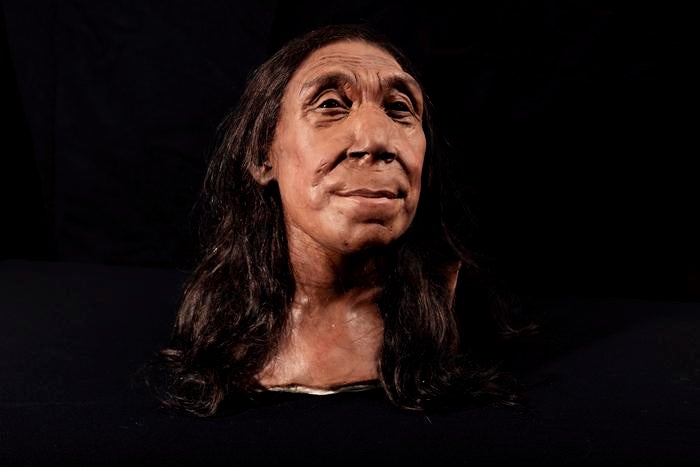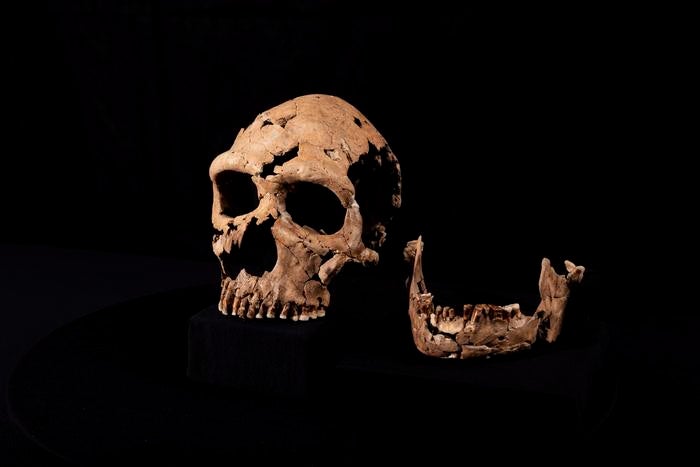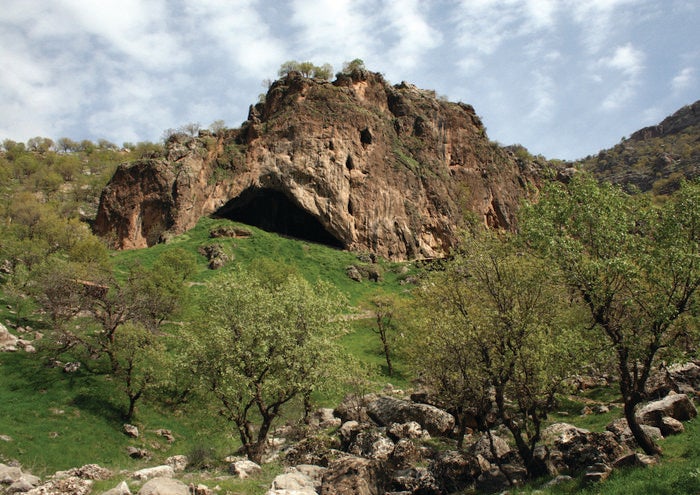
Seeing Red: Our Ancient Relationship With Ocher And The Color Of Cognition – Analysis
Extensive ocher use reflects the culture and cognitive abilities of early humans, who inherited an affinity for red from primate ancestors.
Twenty-three million years ago, our distant ancestors gained trichromatic color vision through means of a random genetic mutation. Trichromatic color vision and trichromacy refer to the ability to perceive color through three receptors in the eye, known as cones, which are sensitive to different wavelengths of visible light.
It has been assumed that primates ancestral to humans had two cones at the start of their lineage; the duplication and modification of genes coding for one of the two created another distinct, separate cone. Gaining a third cone allowed for the perception of red and other colors with long wavelengths in addition to the two preexisting receptors for blues and greens with shorter wavelengths—red was entirely unknown to primate species before this mutation, and the ability to see red remains rare among other mammals. Exceptions to mammalian dichromacy, the state of having two cones, are uncommon. Some primates lost one of their cone receptors, becoming monochromats. Having a single cone, monochromats like the nocturnal owl monkeys (genus Aotus) perceive light intensity in shades of gray without the ability to differentiate color values. Others, including the ancestors of modern apes, monkeys, and humans, happened to gain a third cone.
Michael H. Rowe, professor emeritus of neuroscience at Ohio University, confirms that random processes were involved in the evolution of primate trichromacy in his study of the underlying neurophysiological mechanisms, and outlines the two dominant theories for the maintenance of a third cone among primates. One longstanding theory is that of enhanced fruit detection among diurnal primates, who are most active during the daytime. According to this theory, improved discernment of red fruits against green foliage led to a direct increase in efficiency when foraging for nutritious food.
The second theory, however, suggests it was the consumption of leaves rather than fruit that more strongly influenced routine trichromacy. This alternate “young leaf” hypothesis emphasizes the importance of enhanced color vision when selecting nutritious leaves over their less beneficial counterparts, especially at times when fruit is scarce and surviving off of leaf consumption becomes critical. Rowe’s findings and the newer “young leaf” theory also align with the later evolution of trichromatic vision in the howler monkey, a New World primate.
New World primates like the howler monkey and Old World primates, which include humans and apes, are two major groups within the order Primates that differ in anatomical features and geographic distribution. Since their last common ancestor did not have trichromatic vision, the trait evolved in both Old and certain New World species through convergent evolution. This occurs when similar traits evolve among distantly related species, usually due to similar environmental pressures and advantages to the trait.
Further down the evolutionary timeline, rocks and minerals became the cornerstones of technological advancement among hominins. Within the range of widely accessible raw materials, one pigment stands out with its broad spectrum of color: ocher. Ocher varies in shade depending on its chemical and structural composition, appearing from light yellows and rusty browns to deep red-purple hues. Red ocher, for example, gains its color from an abundance of an iron oxide called hematite.
Known evidence for processing and crushing ocher pieces by early humans in Africa dates as far back as the Early Stone Age. In a 2022 article published by the Journal of World Prehistory, researchers Rimtautas Dapschauskas and his co-authors compared the frequency of ocher use over time between over 100 African archaeological sites. They found that ocher, particularly of the hematite-rich variety, grew in geographical distribution and frequency of use from 500,000 y.a. (years ago) and became part of the cultural behaviors habitual to site inhabitants as early as 160,000 y.a. Over a third of sites included in this study that were used at or after this date contained various forms of the material. Notable ocher finds from Early to Late Stone Age African sites include two intentionally shaped pieces of red ocher from 307,000 y.a. at the Olorgesailie basin in Kenya, as well as a workshop at Blombos Cave, South Africa, for processing ocher 75,000-100,000 y.a. Several of the Blombos Cave specimens display patterns of wear suggesting their use on hard surfaces in the same manner one would use a crayon today.
Ocher pervaded early human history, with many instances of use appearing throughout the archaeological record in accompaniment to technological/utilitarian developments and ritualistic behavior. A few utilitarian applications of ocher include its use in hide-processing, as a skin protectant to guard against mosquitos and excessive sun exposure, and in compound adhesives for tool making. The latter is considered to be one of the best pieces of evidence for advanced cognitive abilities in early humans.
Processing ocher is not unique to Homo sapiens, either, and was a practice shared by other members of the Homo genus. A 2024 study conducted by scientists Patrick Schmidt, Radu Iovita, and their colleagues investigates the use of ocher-based compound adhesives for Middle Paleolithic cutting and scraping tools crafted by Neanderthals (Homo neanderthalensis) at Mousterian rock shelters in France. The researchers found that the adhesive’s ratio of ocher to bitumen was optimal and exact—bitumen loses adhesive properties when mixed with ocher, but the ratio used by Neanderthals creates a mass malleable enough to be formed yet sticky enough to adhere stone tools to handles. The glue’s formula is presumed to be a result of experimentation and costly investments of time and labor, akin to the behaviors and thought patterns of early Homo sapiens in Africa.
Past ritual applications are evident through the intentional selection of ocher based on color. Despite the prevalence of other pigments such as yellow ocher or black manganese in local landscapes, the disproportionate abundance of processed red ocher in large artifact assemblages points to a strong preference for saturated red hues over any other pigment color. Having no obvious instrumental value and inexplicable from a utilitarian perspective, the prolonged repetition of color-driven ocher collection exemplifies ritual behavior.
Burial decoration was another ritual application of ocher. The deliberate burial of human remains appears in many well-established cases from the Upper Paleolithic and Mesolithic periods throughout Europe and Asia. Burials often imply respect for the individual and adornment of the grave or deceased individual was sometimes used to honor the person’s social status or to enhance their appearance. Lawrence G. Straus and his collaborators describe a burial of “the Red Lady of El Mirón” in their 2015 Journal of Archaeological Science article. The “Red Lady,” found in a cave in northern Spain, gained her name from an abundance of red ocher that coats her remains in a bright red hue. Those who buried her used a form of ocher not found in local sources, suggesting it may have been collected elsewhere for special burial rites or preservative use. Another example is a discovery made at Sungir, northeast of Moscow, Russia, where a man and two young children were buried 27,000 years ago. Their grave contained objects including mammoth ivory spears, a variety of ornamental jewelry, and thousands of ivory beads. The burial was covered entirely in red ocher.
Researchers have suggested that the initial catalyst for ocher use may have been its colorful and aesthetic appeal, only later followed by practical applications. With this in mind, it is no surprise that ocher is one of the earliest natural pigments used for artistic expression, including bodily adornment and cave paintings. Two of the oldest known cave paintings are hand stencils in the Cave of Maltravieso of west-central Spain and painted stalactites, mineral formations that hang from cave ceilings, in the Ardales cave of northern Spain. The red pigment decorating these caves has been dated through uranium-thorium testing methods to at least 66,700 and 65,500 years ago, respectively. Today, artists primarily use a synthetic version of red ocher invented in the 18th century. Still, they carry on a very ancient legacy of using this pigment—to create meaningful symbols in meaningful places.
Red ocher has been heavily featured by people across time and continents compared to its undersaturated counterparts, and the color red continues to hold special significance on a global scale. In many East Asian cultures, red represents good fortune and is featured heavily during celebrations. In some Native American communities, red denotes courage and spiritual strength, while other groups associate life, vigor, passion, revolution, and other powerful concepts with the color. The power ascribed to red is also heavily reflected in language—different cultures group the visible light spectrum into categories of different sizes and names. However, an overwhelming majority have a designated word for red no matter how they differentiate between the rest of the rainbow.
Modern people with normal color vision may take the ability for granted, but the capacity to identify shades of red in natural settings served as a significant advantage for our diurnal primate ancestors in terms of survivability and evolutionary fitness. Whether color vision was upheld by the consumption of fruit, foliage, or a combination of both, a new array of visual cues meant new survival strategies and perceptions of the world. In this regard, trichromacy, an accidental evolutionary milestone, paved the way for the widespread cultural gravitation of people toward red and red ocher long before anatomically modern humans existed themselves.
Although past interpretations of ocher have been complicated by its duality in symbolic and practical uses, special attention toward the mineral grows alongside the number of excavated finds. Current research initiatives increasingly recognize the value of the material as a reflection and potential driving force of cognitive and cultural evolution in early humans.
- About the author: Irina Matuzava is a contributor to the Human Bridges project.
- Source: This article was produced by Human Bridges.


